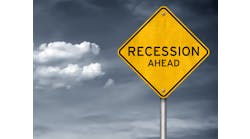Editor's Note: Keeping a close eye on the economy is essential for supply chain management so we will be providing breaking economic analysis from Oxford Economics on a regular basis.
On Feb. 23, 2023, Oxford Economics sent out its second estimate of US Gross Domestic Product.
The second estimate of Q4 2022 GDP didn't paint a meaningfully different picture of the economy than the first estimate. We maintain our view that the recession will start next quarter – caused by the Fed's rate hikes and the past tightening in financial conditions – and that it will be mild compared to previous recessions.
While we continue to forecast a recession, we see risks that it may start later than we currently expect. The batch of monthly data available thus far for 2023, though tainted by seasonal adjustment issues and weather-related idiosyncrasies, shows the US economy is maintaining positive momentum. We anticipate that the economic data will be more downbeat moving forward.
Real GDP grew 2.7% q/q annualized in Q4 according to the second estimate, down from 2.9% initially. Slower consumer spending growth and a smaller boost from net trade stand behind the downward revision, though upward revisions to nonresidential and residential fixed investment offered a partial offset.
Weaker exports and a smaller contraction in imports meant net trade lifted Q4 GDP growth by 0.5ppts, down from 0.6ppts previously. Inventories added 1.5ppts to headline growth, unrevised from the initial estimate. Stripping out trade and inventories, final sales to domestic private purchasers – a gauge of the core of the economy – grew 0.1% annualized, 0.1ppts slower than the initial estimate.
Inflation in Q4 was hotter than previously estimated. The price index for gross domestic purchases (GDP excluding trade) rose 3.6% q/q annualized in Q4, up from 3.2% in the previous estimate. Meanwhile, headline PCE inflation in Q4 was revised up to 3.7% from 3.2% while core PCE inflation was raised to 4.3% from 3.9%.
Overall, inflation trended lower last quarter but remained uncomfortably high. We expect another 25bps rate hike by the Fed in March and further policy tightening in the coming months as policymakers strive to lower inflation and tighten financial conditions.



